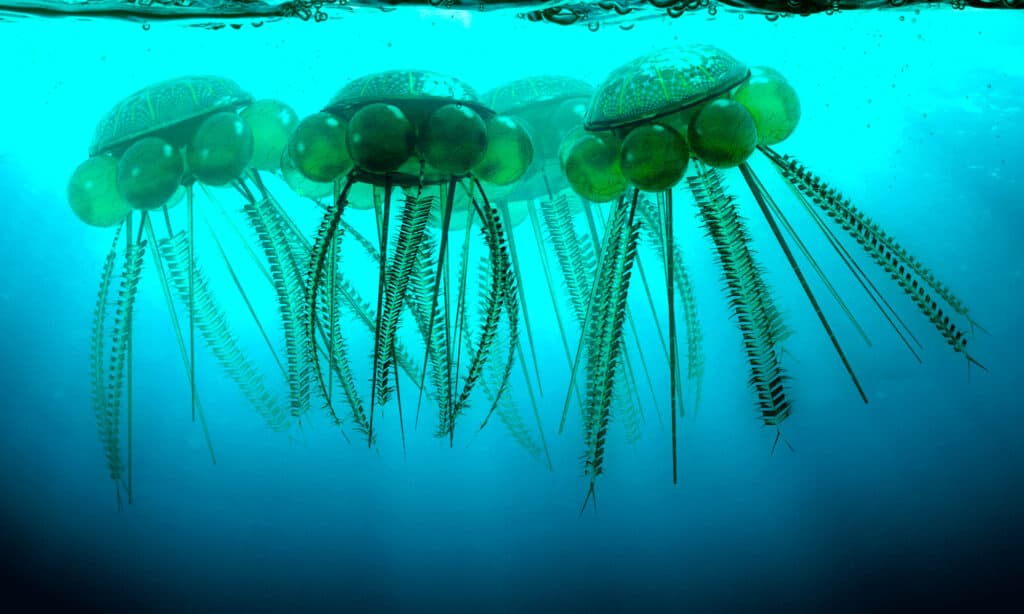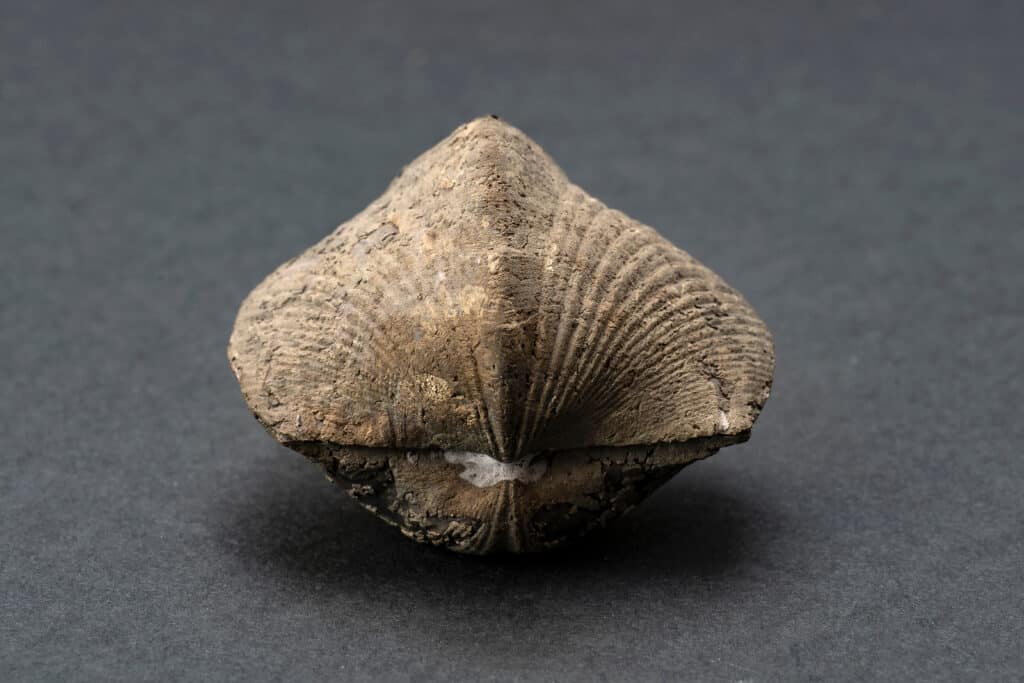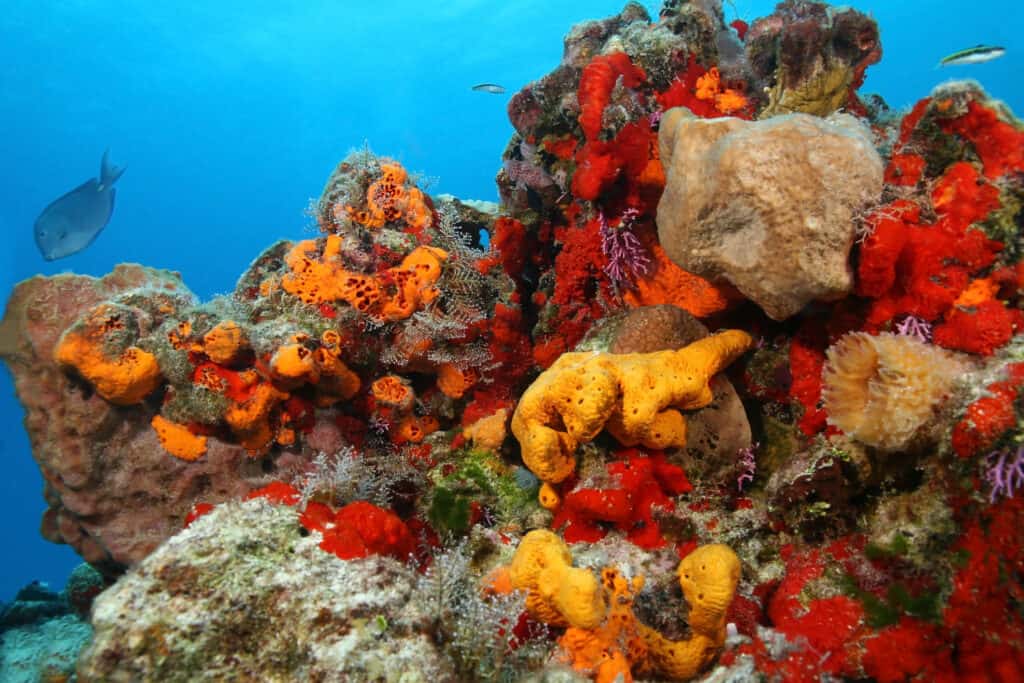The Ordovician Period spanned 45 million years and ended about 443.7 million years ago. During this time, most of the planet’s land mass was in the southern supercontinent Gondwana, and the north was mostly ocean. During the Ordovician, Gondwana drifted toward the South Pole and sank. Ordovician marine invertebrates included graptolites, corals, trilobites, brachiopods, and conodonts (early vertebrates). This community also included red and green algae, primitive fish, cephalopods, crinoids, and gastropods. Recent discoveries of tetrahedral spores resembling early land plants indicate that plants populated the earth at this time. Let’s dive deeper and discover 5 incredible Ordovician Period Animals in this article!
1. Graptolites

Due to their abundance, planktonic lifestyle, and well-traced evolutionary tendencies, graptolites are excellent Ordovician and Silurian indicator fossils.
©Aunt Spray/Shutterstock.com
Graptolites are Pterobranchia Graptolithina colony animals. Chaunograptus is a Middle Cambrian graptolite. Graptoloidea and Dendroidea are two extinct graptolite orders. These orders descended from encrusting pterobranchs like Rhabdopleura. Due to their abundance, planktonic lifestyle, and well-traced evolutionary tendencies, graptolites are excellent Ordovician and Silurian indicator fossils. Many fossils in graptolite resemble hieroglyphic writing on rock; therefore, the word is derived from the Greek words for “written” and “rock.” Linnaeus considered they were “images like fossils” rather than fossils; today, they are largely acknowledged as hemichordates. Rhabdopleura’s stolons join them, making it a colonial plant.
Coenecium, rhabdosome, and tubarium are all names for the colony structure. Early in a colony’s growth, the tubarium branches into varied numbers of stipes and theca configurations; these traits help identify graptolite fossils. Theca are zooid-inhabited tubes. When fossilized, fuselli resemble growth lines, and the two stacks meet in a zigzag pattern. The fuselli, which make up most of a tubarium’s reinforcing, are not fully independent of the brain.
2. Trilobites

Trilobites were already highly diversified and widely spread when they first appeared in the fossil record.
©iStock.com/Aunt_Spray
Trilobites, or “three lobes,” are extinct marine arthropods. In the great extinction that occurred at the end of the Permian epoch about 252 million years ago, the last remaining trilobites gradually perished. Over 20,000 species of trilobites lived in the ocean for 270 million years. Trilobites were already highly diversified and widely spread when they first appeared in the fossil record. Trilobites fossilized quickly due to their diversity and exoskeleton. They have more recently been categorized as members of the Artiopoda, a category that encompasses various species that morphologically resemble trilobites but are mostly unmineralized.
Some trilobites swam and ate plankton, while others were predators, scavengers, or filter feeders. The largest trilobites may have weighed up to 4.5 kilos and measured more than 45 centimeters (18 in) in length (9.9 lb.) (9.9 lb.). Trilobites were active in the Ordovician radiation event, with a new fauna replacing the old Cambrian one, despite intra-species diversity peaking in the Cambrian. Ordovician trilobites thrived on reefs. Trilobites are distinct from other arthropods despite their complicated morphology and ambiguous classification. Sub-elliptical, dorsal, and chitinous exoskeleton separated longitudinally into three distinct lobes. Molting separates the head and thorax, which is why so many trilobite fossils lack one. Trilobites “grew” between molt and new exoskeleton hardening, like lobsters and crabs.
3. Brachiopods

Brachiopods prefer chilly water and low light.
©Myriam B/Shutterstock.com
Brachiopod phylum Brachiopoda are a phylum of trochozoan organisms, not bivalves. The front of a brachiopod valve can be opened for eating and closed for protection. The valve-tooth-and-groove hinge’s “articulate” features are absent from the inarticulate group. This skeletal feature makes it easier to identify the two main fossil groups. Articulated brachiopods have simple, vertically oriented muscles and toothed hinges. Inarticulate brachiopods have weak, toothless hinges and a complex network of vertical and oblique muscles to maintain valve alignment. Many brachiopods have a stalk-like pedicle projecting from the pedicle or ventral valve. The pedicle secures the animal to the bottom and keeps the passage clear.
Brachiopods avoid currents and waves. While inarticulate species’ larvae float for a month and have wide ranges, articulate species’ larvae settle quickly and form dense communities in well-defined regions. Brachiopods prefer chilly water and low light. Perhaps because their flesh is unpalatable, fish and crustaceans rarely eat brachiopods. Only lingulids have been fished commercially and not often. “brachiopod” comes from the Greek words brachion and podos (“foot”). Terebratulida shells are called “lamp shells” because they resemble earthenware oil lamps.
4. Conodonts

Conodonts were long known only from enigmatic tooth-like microfossils (200 nm to 5 mm).
©Nobu Tamura email:[email protected] http://spinops.blogspot.com/ http://paleoexhibit.blogspot.com / CC BY-SA 4.0 – License
Conodonts are extinct agnathan (jawless) animals that resembled eels. Long ago, they were only known by their isolated, tooth-like mouthparts. They were in the world’s oceans from the Cambrian through the Jurassic. Many indicator fossils—fossils that designate geological periods—use conodonts. The rest of the animal’s fossils weren’t uncovered until the 1980s. In the 1990s, South African fossils preserved soft tissue and muscle fibers in clay. Conodonts were long known only from enigmatic tooth-like microfossils (200 nm to 5 mm) that sometimes, but not typically, appear alone and are unrelated to any other fossil. Because of its fragile body, only the conodont’s teeth could be preserved.
They were early vertebrates because they could spin their eyeballs using muscles. In 11 preserved conodont bones, an eel-like creature has 15 or 19 bilaterally symmetrical components on its cranium. Conodonts had chevron-shaped muscles, huge eyes, fin rays, and notochords. Conodont components have varying morphologies and levels of complexity.
5. Corals

Most corals obtain energy and sustenance from photosynthetic dinoflagellates of the genus Symbiodinium that live in their tissues.
©Brian Lasenby/Shutterstock.com
Coral “groups” are colonies of related polyps. Polyps are tiny animals that resemble sacs a few millimeters in diameter and a few centimeters tall. Coral species release calcium carbonate to form a skeleton in tropical waters. Some corals may catch plankton and small fish using stinging cells on their tentacles. Most corals obtain energy and sustenance from photosynthetic dinoflagellates of the genus Symbiodinium that live in their tissues. Such corals grow in shallow, clean seas no deeper than 60 meters (200 feet; 33 fathoms). Tropical and subtropical coral reefs, like Australia’s Great Barrier Reef, rely on corals for structure. Other corals, such as the cold-water genus Lophelia, can live worldwide in much deeper water (10,800 feet; 1,800 fathoms).
Even though a few coral-like species existed in the Cambrian, corals didn’t play a substantial role in marine ecology until the Ordovician. Ordovician corals were Tabulata, Rugosa, and Heliolitida. Tabulata created honeycomb-like structures from its hexagonal cells. The most well-known Rugosa corals were the horn corals, which were solitary polyps that developed a conical or horn-like ‘shell.’ They formed symbiotic relationships with worms that penetrated their basal openings. Heliolitida, the tiniest, helped construct reefs. Ordovician reefs had more corals, but algae, sponges, and bryozoans dominated. Heliolitida died off during the Devonian mass extinction. Tabulata and Rugosa corals survived and thrived until the end of the Permian epoch.
Conclusion
Ordovician living patterns changed significantly worldwide. Gondwana’s shallow waters bred new trilobites. By the end of the period, many graptolites’ species were extinct, but planktonic graptolites appeared. During the late Lower Ordovician, conodont diversity dropped in the North Atlantic Realm but increased elsewhere. Nine new conodont lineages developed after the extinction of seven major lineages.
These lineages had many taxa with different morphologies. Gondwana craton nearly sank due to sea level rise. Conodonts had attained their evolutionary peak. Ordovician fossils are the oldest complete vertebrate fossils, notwithstanding Cambrian vertebrate bone parts and soft-bodied kin. Ordovician nearshore marine strata in Australia, South America, and western North America contain these fossils.
Related Animals:
The photo featured at the top of this post is © iStock.com/Aunt_Spray
Sources
- WGBH Educational Foundation and Clear Blue Sky Productions, Inc., Available here: https://www.pbs.org/wgbh/evolution/change/deeptime/ordovician.html
- National Park Service, Available here: https://www.nps.gov/articles/000/ordovician-period.htm
- Kentucky Geological Survey, Available here: https://www.uky.edu/KGS/fossils/fossil-region-ordovician-period.php
- Geology Page, Available here: https://www.geologypage.com/2014/03/ordovician-period.html
Thank you for reading! Have some feedback for us? Contact the AZ Animals editorial team.






